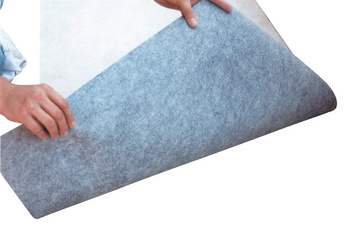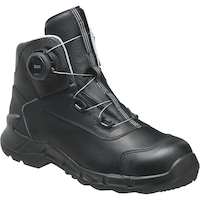Balcony sealing and uncoupling membrane CERAfix® 315
Sealing and isolation strip balcony CERAfix 315
WTRPROF/DECUPLMEMBR-(CERAFIX-315)-15M
Art.-no. 5875100315
EAN 4047376970823

Register now and access more than 125,000 products
Impermeable to water
Protects the surface from moisture
Equalises vapour-pressure
Due to the fleece on the back, the air ducts remain on the bottom; these ducts have a vapour-equalising effect and thus discharge the enclosed moisture
Easy to apply
The specified layer thickness of the film ensures that a sufficient sealing layer is achieved
Bridges cracks
Improved bridging of cracks compared to, for example, when using slurry-type seal coatings
Highly elastic
Increased flexibility compared to, for example, when using slurry-type seal coatings
- Traffic loads up to 3.5 kN/m² spot loads up to 2.0 kN/m²
- Resistant to micro-organisms
- UV stable
CERAfix 315 is a special design. We therefore recommend a contractual and written agreement.
- Before applying CERAfix 315, spread a contact layer with CERAfix 300/301 on existing supporting tile surfaces and allow to harden!
- CERAfix 315 is not suitable for high dynamic loads such as with industrial traffic!
- CERAfix 300/301/SMP Sprint can be used to seal suitable edge and gutter elements. The substrate must then be prepared in a suitable manner, e.g.: Direct contact with metals such as copper, zinc and aluminium must be prevented by using a pore-tight primer with CERAfix 103/203 and TEGAfix quartz sand. A pore-tight primer is produced in two stages with CERAfix 203 or CERAfix 103. The first stage involves liberal application to the substrate cleaned with acetone (check compatibility) and careful coating. Once this layer has begun to react such that it can no longer be spread through (about 3-6 hours*), another epoxy resin layer is applied and scattered with TEGAfix 430 quartz sand. Consumption approx. 800 g/m². A connection to the surface seal is then formed over the cured blinding layer, e.g. using CERAfix 316 sealing tape with CERAfix 300/301/SMP Sprint.
- To decouple wood substrates, we recommend decoupling panels CERAfix 206.
- Edge, field, building and movement joints must be carried over or integrated at the specified locations and suppressed by suitable means, e.g. edge insulating strips! Dummy joints must be friction-locked or secured against height offset and formed as a movement joint in the surface covering.
- CERAfix 315 must not be adhered or worked over with solvent-containing products!
- On cool, damp surfaces and in rooms with high humidity and/or low temperatures, an extended drying time of the structure is to be expected. In such cases, the product will take longer to reach a load-bearing state, including resistance to water.
- Protect the CERAfix 315 construction from the effects of water and freezing in the installed state until complete drying; this will take longer in unfavourable weather conditions compared to normal conditions*.
- The relevant applicable technical information sheets of the indicated products must be observed!
Current applicable regulations must be observed! For example:
- DIN 18157
- DIN 18352
- DIN 18560
- DIN EN 13813
- DIN 18202
- DIN 1055
BEB information sheets, published by Bundesverband
Estrich und Belag e. V. (Federal Association for Screeds and Coverings) "Interface coordination for heated floor constructions"
ZDB information sheets, published by the German tiling industry association:
- [*1] "Compound sealing"
- [*2] "Coverings on calcium sulphate screed"
- [*3] "Movement joints in tile and panel facings and coverings"
- [*5] "Ceramic tiles and panels, natural stone and artificial stone on cement-bound floor structures with insulation layers"
- [*6] "Ceramic tiles and panels, natural stone and artificial stone on heated cement-bound floor structures"
- [*7] "Outer coverings"

The above application instructions are recommendations given on the basis of our own tests and experience. We recommend that you carry out your own tests before use. Due to the great variety of different applications and storage and processing conditions, we cannot guarantee a particular application result. We will not accept legal liability for any advice or technical information provided by our free customer hotline unless this advisory service and/or technical information is part of the contractually agreed performance owed by us, or the customer service employee acted willfully or intentionally. We guarantee the consistent quality of our products and reserve the right to make technical changes and improvements.
Datasheets(X)
CERAfix 315 is used to seal balcony and terrace surfaces and to isolate ceramic coverings from tiles and panels.
Balconies and terraces can be sealed using CERAfix 315 after the screed has sufficiently set. Tiles and panels can then immediately be laid.
CERAfix 315 is suitable in load classes A0 and B0 in accordance with Central Federation of the German Building Trade's technical information leaflet "Joint seals". CERAfix 315 can also be used for decoupling in buildings for residential purposes, with working loads up to 2 KN/m2.
Substrate:
The substrate must be load-bearing, sufficiently flat in accordance with DIN 18202, and free from cracks and loose substances. The substrate must have a largely closed surface quality and strength that corresponds to its type.
Smooth concrete surfaces must be roughened. Prime substrates according to their requirements.
All flat, load-bearing surfaces that can support tiles and panels are suitable and are therefore suitable for accepting tile compound sealant. Furthermore, the suitability of the substrate must be mentioned in the corresponding moisture resistance classes (observe the Central Federation of the German Building Trade's technical information leaflet).
Separating cracks must be assessed by experts and, where necessary, be sealed non-positively with CERAfix 203.
Compensate for a height offset on the laying substrate in advance by applying CERAfix 201 or CERAfix 202. Moisture ingress from the underside of the sealing layer must be excluded.
In areas exposed to moisture, a sufficient slope of at least 1.5 %, must be formed in advance, in the direction of drainage.
Floor drains should be provided with thin bed flanges that have a minimum all-round width of 5 cm and should be made of a material suitable for bonding, e.g. stainless steel, gunmetal or PVC-U.
Hot screeds must be heated before covering work, in line with technical regulations. To assess how mature the covering is, perform a moisture measurement using the CM unit. The CM moisture content must not exceed 2.0 CM% for cement screeds, 0.5 CM% for screeds on insulation or a separation breather and calcium sulphate screeds without underfloor heating, and 0.3 CM% for calcium sulphate screeds with underfloor heating. The CM measurement must be conducted in accordance with the current work instruction "Interface coordination for heated floor constructions". Calcium sulphate substrates or substrates sensitive to moisture are only acceptable for indoor use with no exposure to moisture and where only decoupling needs to be carried out.
Application:
Over the substrate, comb through a CERAfix PLUS system tile adhesive with a 4-6 mm notched trowel and insert CERAfix 315 balcony and uncoupling membrane; carefully apply pressure to the membrane. Ensure bedding across the entire surface. The joints should be filled with a wide coating of approx. 15 cm using CERAfix 300/301 or SMP Sprint and the joint tape provided should be carefully inserted and pressed into them. For laying tiles, spread the mixed CERAfix PLUS on top of CERAfix 315 and, depending on the board size, comb through with a suitable notched trowel and lay the covering material within the adhesive drying time.
- Check and clean the substrate, and prepare according to specifications. If necessary, roughen and clean facing panel profiles, floor drains, and degrease with an agent such as acetone (check material compatibility!).
- Put clean water in a clean mixing bucket, add CERAfix PLUS system adhesive and mix using a Würth agitator (approx. 500 rpm) until there are no lumps. To lay CERAfix 315, a supple, smooth consistency must be used to achieve good connection with the CERAfix 315 needle felt.
- Cut CERAfix 315 to fit with a blade or scissors. Comb the CERAfix PLUS tile adhesive over the prepared substrate with a notched trowel that is at least 4 mm and maximum 6 mm wide; the adhesive should be approx. 10 cm wider than the film width. Then add the CERAfix 315 to the adhesive bed and firmly push into the adhesive bed with a smooth comb or a roller to ensure that there are no cavities or wrinkles. It must be ensured that the dark side (needle felt) of the CERAfix 315 on the roller facing outwards is bonded to the substrate. Complete bedding and good cross-linking from the non-woven fabric to the adhesive must be ensured. The cut strips are laid so they are blunt and flush with each other.
- On account of the non-woven lamination on the back, CERAfix 316 sealing tapes must always be connected to the upper side of CERAfix 315 - thin non-woven fabric - to ensure that capillary water transport is excluded.
- The joints between the individual strips are reworked with the balcony joint tape contained in the scope of delivery or CERAfix 316. To do this, use a 4 mm notched trowel to apply the tape on both sides of the joint to be bridged; carefully press the balcony joint tape in place with a smoothing trowel so that there are no cavities or wrinkles.
- Bond CERAfix inner and outer corners on the CERAfix 315 and on the prepared wall surface in the corner areas, in the transition between the wall and floor as well as over connection joints with a layer of CERAfix 300/301/SMP Sprint so that there are no cavities and wrinkles. Sealing tape joints have an overlap of at least 5-10 cm. It must be ensured that a tight seal is produced between the wall and surface seal.
- Drains must have suitable thin bed flanges. Apply CERAfix 300/301/SMP Sprint using a 6 mm notched trowel. Bed CERAfix floor sealing collar into the CERAfix 300/301/SMP Sprint layer so there are no cavities or folds; this is to create a tight bonded connection to CERAfix 315.
- The tiles or boards must have a minimum surface of 100 cm² and minimum tensile strength of 1,500 N. Lay the frost-resistant tiles or boards with CERAfix PLUS system tile adhesive within the adhesive drying time so that there are no virtually no cavities. Produce a contact layer on the CERAfix 315 and then comb through evenly with a suitable toothed trowel, depending on the board size. Tiles or panels can be laid directly on freshly laid CERAfix 315 when the seal has corresponding protection and a distribution of the load is ensured. For outdoor use, a virtually cavity-free bedding of tiles must be ensured.
- CERAfix joint agent is used to join tile coverings, even on natural stones. Keep moving joints free to ensure elastic joining.
- The sealing of the connection and movement joints is carried out with suitable Würth sealants.
Material | Fleece (top and bottom side) / membrane (middle) |
Colour | Light grey (bright grey) |
Included in delivery | 20 m joint tape |
Length of roll | 15 m |
Roll width | 1 m |
Thickness | 1.2 mm |
Min. surface processing temperature | 5 °C |
Max. surface processing temperature | 25 °C |
Max. temperature resistance | 90 °C |
Min. temperature resistance | -22 °C |
Resistance against | Alkali, Thawing-freezing alternations, Micro-organism, Water |
Ultraviolet resistance | Yes |
Min. water-vapour permeability (pressure) | 3 bar |
Min. diagonal elongation | 40 % |
Min. longitudinal elongation | 40 % |
Shelf life from production | 24 Month |
Select RAL-colour code
!! NOTE: On-screen visualisation of the colour differs from real colour shade!!

















